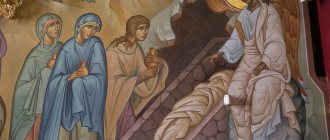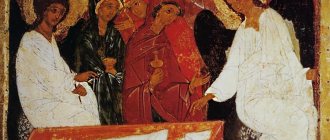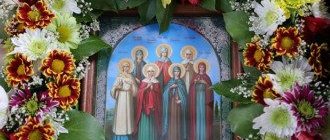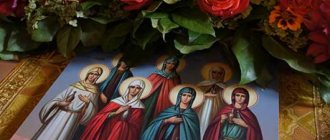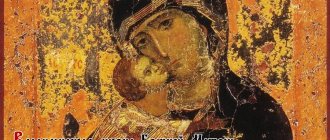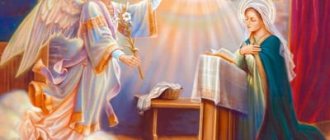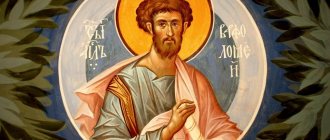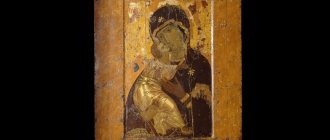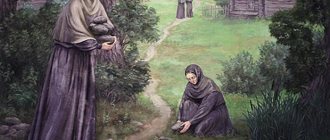Why do saints have this name?
Myrrh-bearing wives are women who were able to see with their own eyes the painful death of Christ and all the events associated with it. They saw the great earthquake, the solar eclipse, and the resurrection of the righteous that happened during the crucifixion. These women interacted with Jesus during their lifetime and welcomed him into their homes. Currently, the Day of the Holy Myrrh-Bearers is considered a serious Orthodox holiday, which is celebrated annually. For many believers, these women are a symbol of selflessness and the approach of good news.
The following women are classified as myrrh-bearing wives:
- Mary Magdalene. This is one of the first followers of Christ. Thanks to her acquaintance with Jesus, she said goodbye to her dissolute life and took the righteous path. Subsequently, she devoted her life to worship and keeping church covenants.
- Maria Kleopova. This is the second woman who became a preacher of Jesus. The story of Mary's origins remains controversial and unclear even to this day. Some claim that she is Magdalene's sister. However, there is information that she is a relative of Joseph the Betrothed.
- John. One of the most faithful disciples of Christ, who served him until his last days. She dedicated her life to accompanying Christian novices. It was also Joanna who managed to preserve the head of the Baptist.
- Salome. This is the mother of John and James, who were disciples and apostles of Jesus. It was Salome who saw Christ first after the resurrection.
- Sisters Maria and Martha. Christ repeatedly communicated with these girls and read sermons to them. Jesus' words impacted and changed the lives of the sisters dramatically. After meeting the Savior and raising Lazarus, they believed in the Lord and began to preach the Word of God.
- Susanna. This female name is mentioned several times in the Gospel. It is known that she was a faithful servant of the Messiah who helped him in everything.
It was thanks to the above women that the feast of the Myrrh-Bearing Women appeared, which is celebrated by Orthodox people to this day.
Myrrh-Bearing Wives
[Greek μυροφόροι γυναίκες] (memorial 3rd Sunday after Easter), followers of Jesus Christ, the first to come to the burial cave, where the body of the Lord had been laid the day before, in order to anoint Him with fragrant oils, according to Jewish custom, and mourn Him.
Myrrh-Bearing Women at the Holy Sepulcher. Icon of the festive rite of the iconostasis of the Trinity Cathedral of the Trinity-Sergius Lavra. OK. 1425 Myrrh-Bearing Women at the Holy Sepulcher. Icon of the festive rite of the iconostasis of the Trinity Cathedral of the Trinity-Sergius Lavra. OK. 1425 The Gospels, using almost the same expressions, tell us that during the crucifixion of Christ many. the women who “followed Him from Galilee” (Luke 23.49) were there and watched from afar (Mt 27.55-56; Mk 15.40-41; Lk 23.49; John 19.24-27). In John 19.25 it is reported, in contrast to the Synoptic Gospels, that “His mother and sister of His Mother, Mary of Cleophas (ἡ τοῦ Κλωπᾶ) and Mary Magdalene” together with the ap. John the Theologian stood next to the Cross. During the period of His earthly ministry, many of J.-m. They served Him, including “with their substance” (Luke 8:2-3). After the death of Christ, some of them participated in His burial not far from the place of execution (Matthew 27.59-61; Mark 15.46-47; Luke 23.53-55; cf. John 19.40-42). After Saturday, when the first day of the week began, they were the first to come to the burial cave to anoint the body of the Savior (Mark 16.1), that is, to perform the necessary funeral rite, which consisted of rubbing the deceased with special fragrant mixtures, temporarily weakening the speed and smell of decomposition (McCane. 2000. P. 174-175). J.-m. presented differently among the evangelists. Thus, in the Gospel of Matthew only Mary Magdalene and “the other Mary” are mentioned (Matt 28.1); in the Gospel of Mark - Mary Magdalene, Mary Jacob (Μαρία ἡ ᾿Ιακώβου; cf.: Mk 15.40) and Salome (Mk 16.1); in the Gospel of Luke - “Mary Magdalene, and Joanna, and Mary the mother of James, and others with them” (Luke 24:10). According to the testimony of the Evangelist John, of the women that morning only Mary Magdalene came to the tomb twice (John 20. 1-2, 11-18). Thus, all the Gospels report the presence of Mary Magdalene at the burial cave, and the weather forecasters agree in their testimony that she came to the tomb along with Mary, the mother of James and Josiah, and the mother of the sons of Zebedee (cf. Mt 27.56 ). In the story of the walk to the tomb, the evangelists Mark and Luke also include Salome and Joanna, respectively.
Salome, in addition to Mark 16.1, is mentioned in Mark 15.40 (together with Mary Magdalene and Mary, mother of James and Josiah). Comparing Mark 15.40 and Matthew 27.56, we can assume that she is the “mother of the sons of Zebedee,” who, shortly before the Lord’s entry into Jerusalem, asked Him to make her sons (James and John) the first after herself in the Kingdom of God (Matthew 20:20-23).
The Evangelist Luke speaks about John, except in Luke 24.10, in Luke 8.3, when he lists by name the disciples of Christ who followed Him through Galilee. There she is called “the wife of Chuza, Herod’s steward” (meaning King Herod Antipas). There is no further mention of her in the NT. Apparently, the evangelist, if he knew the Gospel of Mark, wanted to use the expression “and the rest with them” to harmonize the message of the evangelist Mark with the information he had about those who were then near the tomb (see: Nolland. 1998. P. 1191 ). If this Gospel was not at his disposal, then he probably simply summarized in this phrase all the information he had about the women who came to the tomb of the Savior. He honors John by name in the story of visiting the empty tomb along with 2 women also named by name, trying to emphasize, as J. Nollend suggests, the importance of her serving the Lord and the apostles with her wealth (Ibidem).
Myrrh-Bearing Women at the Holy Sepulcher. Avoriy IV-V centuries. (British Museum, London)
Myrrh-Bearing Women at the Holy Sepulcher. Avoriy IV-V centuries. (British Museum, London) The most controversial issue among interpreters was and still is the identification of “Mary, mother of James the less and Josiah” (᾿Ιωσῆτος - Ioseta - Mark 15.40) or Joseph in Greek. text (᾿Ιωσήφ - Matthew 27.56). There are 2 main views on this matter: Mary (called “the other Mary” in Matthew 27.61) Bl. Jerome of Stridon identified with Mary of Cleopas (John 19.25), sister of the Mother of God and wife of Cleopas (Κλεοπᾶς) mentioned in Luke 24.18 (Hieron. De virgin. 13 // PL. 23. Col. 195c-196b; see also: Zahn. 1900. S. 320-325). According to another interpretation, which was adhered to, in particular, by St. John Chrysostom, it is the Mother of God who is mentioned among J.-m. in the Gospel of Matthew under the name of “Mary, the mother of James and Josiah” (Matt. 27.56), as well as “the other Mary” (Matt. 27.61; 28.1) (Ioan. Chrysost. In Matt. 88 // PG 58. Col. 777; see also: Theoph. Bulg. In Math. 27 // PG. 123. Col. 473). Blzh. Theophylact of Bulgaria writes: “By Mary, the mother of Jacob, understand the Mother of God, for She was so called as the imaginary mother of Jacob, the son of Joseph, I mean the brother of God” (Idem. In Luc. 24 // PG. 123. Col. 1112). The fact that the “other Mary” and the Mother of God are one person is stated in the synaxaran reading on the Holy Week of Easter. From modern A similar interpretation is defended by researchers, for example, J. Crossan, who suggests that the Evangelist Mark does not call this Mary the Mother of Jesus because, as he believes, she was not a follower of Christ during His earthly life (see: Mark 3 . 21, 31-35; 6. 4), and therefore prefers to distinguish her from women of the same name by indicating children (see: Crossan. 1973. P. 105ff.), even adopted ones (according to the opinion, for example, Epiphanius of Cyprus (Epiph. Adv. haer. 78. 8 // PG. 42. Col. 710-712; see also: Glubokovsky. 1999. P. 94-97).
Myrrh-Bearing Women at the Holy Sepulcher. Mosaic c. Sant'Apollinare Nuavo in Ravenna. Before 526
Myrrh-Bearing Women at the Holy Sepulcher. Mosaic c. Sant'Apollinare Nuavo in Ravenna. Before 526. As for the identification of the "other Mary" with "Mary of Cleopas", there are difficulties with what the definition of "Cleopas" means: "mother of Cleopas", "sister of Cleopas" or, most likely, "wife of Cleopas" . It is definitely impossible to decide this due to the paucity of documentary evidence about this Mary (Witherington. 1992. P. 582). However, the early Christ already considered her “the wife of Cleopas.” author Egesippus (mid-2nd century; see: Euseb. Hist. eccl. III 32.4). In addition, it remains controversial whether the expression “His Mother’s sister” in John 19.25 refers to the indicated Mary, or whether it indicates another unnamed woman who stood at the Cross of Christ (Bauckham. 2002. P. 204-206) . Eusebius of Caesarea believed that the “other Mary” should be understood as the second Mary from Magdala, which is why she is named so as to distinguish her from Mary, called Magdalene (Euseb. Quaest. evang. II 6 // PG. 22. Col. 948) , however, this opinion is not widespread.
Researchers have pointed out a contradiction in the Gospels regarding the rite of anointing: in the synoptic Gospels, when describing the position of the Savior’s body in the tomb, there is no mention of anointing and the desire of J.-M., having come to the grave, to anoint him is emphasized; the Gospel of John tells that the body of Christ was anointed by Joseph of Arimathea and Nicodemus before placing it in the tomb. Various assumptions have been made about the reasons for these discrepancies: for example, the words about the actions of Nicodemus are considered an editorial insertion by the Evangelist John, with the help of which he wanted to emphasize the courageous discipleship of both Nicodemus himself and Joseph (Paulien. 1992. P. 1105). Ep. Cassian (Bezobrazov), however, allows for the possibility of a historical resolution of this contradiction: “Joseph and Nicodemus, on the one hand, and the women, on the other, acted independently of each other. It is possible that the faithful Galilean women did not know the secret disciples” (Cassian (Bezobrazov). 2006. P. 337).
Myrrh-Bearing Women at the Holy Sepulcher. Fragment of a reliquary from the Sancta Sanctorum chapel. OK. 600 (Vatican Museum)
Myrrh-Bearing Women at the Holy Sepulcher. Fragment of a reliquary from the Sancta Sanctorum chapel. OK. 600 (Vatican Museum) Mn. interpreters have paid and are paying attention to the mention by the Evangelist John in the story of the coming to the tomb of only Mary Magdalene (John 20. 1). Blzh. Augustine, discussing this feature of the 4th Gospel, says that Mary Magdalene was mentioned because she was “flaming with greater love,” while others were implied along with her, but he kept silent about them (Aug. De cons. evang. III 24 // PL 34. Col. 1201). The consistency of the message of the Gospel of John with the messages of the Synoptic Gospels is supported by Mary’s expression “and we do not know” (John 20.2), i.e., thereby hinting at the presence of other women at the tomb along with Mary. However, the discussion about the meaning of this expression does not stop (see: Beasley-Murray. 1999. P. 368 sqq.) Many researchers try to explain the indicated discrepancy between the Gospels or the intention of the Evangelist John to dramatize the scene of the appearance of the Risen One, or the special position of Mary Magdalene in the original Churches, etc. (see: Witherington. 1992. P. 582).
Myrrh-Bearing Women at the Holy Sepulcher. Ampoule. VI-VII centuries (Dumbarton Oaks, WA)
Myrrh-Bearing Women at the Holy Sepulcher. Ampoule. VI-VII centuries (Dumbarton Oaks, Washington) Giving a general theological description of the story of J.-M.’s walk. to the tomb, biblical scholars point out in the description of the episode with the myrrh-bearers in the Gospel of Mark the presence of an element of irony: Jesus is not only the Messiah (cf. Mark 14.3), He has already risen, and therefore it is no longer possible to anoint His body after death. “The irony towards women for their lack of understanding of the situation is also present in the description of their anxiety about finding a person who would help them roll away the stone (Mk 16.3), for the stone was “... very large” (Mk 16.4) "(Osborne. 1992. P. 678-679). “In general, Mark 16. 1-4 focuses on the misunderstanding of the situation by women (who play a significant role in Mark’s development of the theme of discipleship) and leads the reader to perceive Divine intervention as the only possible solution to this situation” (Ibidem). The evangelist Matthew follows Mark in many ways, but unlike him, he does not emphasize the errors of the women who were going to anoint the body of Jesus with incense; the theme of the testimony of women is more important to him (cf. Matt. 27.56, 61) (Osborne. 1992. P. 679). In addition, it is possible that in the Gospel of Matthew, with its silence, as in the Gospel of John, the funeral anointing is discussed about the custom of visiting the recently deceased in order to be sure of his death - “... to look at the tomb” (Matthew 27.61) (Hagner 1995, p. 869).
Evangelist Luke, like Evangelist Matthew, revises the list of names and adds the phrase “and others with them” (Luke 24.10), thereby strengthening the role of women as witnesses of the resurrection of Jesus Christ (Osborne. 1992. P. 682). As for the Gospel of John, “all four episodes of chapter 20 depict a crisis of faith, since the participants (including Mary Magdalene. - P.L.) of the events that preceded and followed the Resurrection do not fully understand everything that is happening” (Ibid. P. 682, 684-685). But Christ Himself helps them to come to full comprehension of the Resurrection through the revelation of His divine nature (Schnackenburg. 1982. P. 335). St. John Chrysostom emphasizes in his interpretation of the story about the walk to the Tomb of the Savior “the courage of women... fiery love... generosity in costs... determination to death itself” (Ioan. Chrysost. In Matth. 88 // PG. 58. Col. 778), calling on Christians imitate them.
The story about Mary Magdalene, who came to the grave of the Savior with other women, has also been preserved among those who have survived to this day. the time of fragments of the apocryphal Gospel of Peter (12.50-54; 13.55-57), compiled in the 2nd century. It, with the exception of minor details, does not contain anything new compared to the stories of the canonical Gospels, apparently being an eclectic text (Brown. 1997. P. 835).
On the day of remembrance of St. J.-m. The Regency School at the MDA traditionally hosts an evening dedicated to J.-M. (Makariy [Veretennikov], archimandrite. Creative evenings at the Regency School // AiO. 2008. No. 2(52). P. 326-327).
Lit.: Zahn Th. Brüder und Vettern Jesu. Lpz., 1900. S. 225-364; Glubokovsky N. N. The Gospel of Christ. freedom in the message of St. ap. Paul to the Galatians. Sofia, 1935. M., 1999. pp. 89-98; Crossan JD Mark and the Relatives of Jesus // NTIQ. 1973. Vol. 15. Fasc. 2. P. 81-113; Schnackenburg R. The Gospel According to St. John. L., 1982. Vol. 3: Comment. on Chap. 13-21. P. 300-335; Osborne G. Resurrection // Dictionary of Jesus and the Gospels / Ed. J. B. Green et al. Downers Grove (Ill.), 1992, pp. 673-688; Paulien J. Nicodemus // ABD. 1992. Vol. 4. P. 1105-1106; Witherington B. Mary (2) // Ibid. P. 582; Brown RE Death of the Messiah: From Gethsemane to the Grave. L., 1994. Vol. 2: A Comment. on the Passion Narratives in the Four Gospels. P. 1012-1030, 1052-1098; idem. An Introduction to the NT. NY; L., 1997; Hagner DA Matthew. Dallas (Tex.), 1995. Vol. 2: 14-28. P. 865-871. (WBC; 33b); Holland J. Luke. Dallas, 1998. Vol. 3: 18:35-24:53. P. 1168-1194. (WBC; 35c); Beasley-Murray GR John. Nashville (Tenn.), 19992, pp. 364-378, 388-391. (WBC; 36); McCane BR Burial Practices, Hebrew // Dictionary of New Testament Background / Ed. C. A. Evans, S. E. Porter. Downers Grove; Leicester (UK), 2000. P. 173-175; Bauckham R. Gospel Women: Stud. of the Named Women in the Gospels. Grand Rapids (Mich.); Camb., 2002. P. 203-247, 257-311; Cassian (Bezobrazov), bishop. Lectures on the NT: The Gospel of John. M.; P., 2006. pp. 330-343.
P. Yu. Lebedev
Hymnography
Glorification of J.-m. in Orthodox hymnography is closely connected with the glorification of the Resurrection of Christ, since J.-m. They were the first to come to the Life-Giving Tomb and receive the news of the Resurrection. The main day of glorification of J.-m. is the 3rd Week (Sunday) after Easter (there is a deliberate mention of J.-m. in the canon of the 5th Week after Easter, about the Samaritan: in each song of the canon there is 1 or even 2 troparions dedicated to J.-m. ), but they are also remembered on Holy Saturday, and throughout the year - on each of the Sundays (unless the Sunday service is canceled due to the coincidence of Sunday with the Twelfth Feast of the Lord).
In the Sunday successions of Octoechos J.-m. are mentioned in at least 1-2 stichera, almost always in the sedalna at Matins, sometimes in the ikos of Sunday kontakia; at the liturgy for the blessed, as a rule, there is also a troparion (as a rule, this is the 5th troparion; sometimes 2 troparions), in which J. m. is glorified. In the Sunday canons, mention of J. m., on the contrary, is sufficient rare.
Myrrh-Bearing Women at the Holy Sepulcher. Miniature from the Gospel and the Apostle. XI century (Ath. Dionys. 587m. Fol. 113v) Myrrh-bearing women at the Holy Sepulcher. Miniature from the Gospel and the Apostle. XI century (Ath. Dionys. 587m. Fol. 113v) Orthodox. hymnographers in chants in honor of J.-m. describe the feat of J.-M., who overcame the fear of the authorities, went to the Tomb of Christ and witnessed the appearance of an angel: (1st verse according to the 2nd verse of the Sunday service of the 1st tone), (2nd troparion 3 hymn of the Resurrection of the Cross canon, 5th tone), etc. It is emphasized that they were the first evangelists of the Resurrection: (ikos of the Sunday kontakion, 1st tone), sometimes the unusualness of this situation is clearly presented - J.-m. preach the Resurrection to those who have been chosen for the gospel: (1st verse according to the 1st verse of the Sunday service, 6th tone). Grief J.-m. contrasted with the joy of the Resurrection that replaced him: . The phrase: (1st eastern on the praises of the Sunday service of the 2nd voice) refers to a kind of poetic exaggeration, as well as the attribution to J.-m. original knowledge of the Resurrection: (3rd eastern on the praises of the Sunday service of the 4th tone). The boldness of the wives is compared with the fear of the saint himself. Peter: (1st sedalon according to the 2nd verse of the Sunday service, 5th tone). Some hymns tell the story of the appearance of Christ to Mary Magdalene (2nd verse according to the 1st verse of the Sunday service, 6th tone, etc.). In a special way the theme of J.-m. presented in the Gospel stichera and Sunday exapostilaria, retelling the corresponding Gospel conceptions.
Some of the J.-m. have their own separate days of remembrance: equal. Mary Magdalene - July 22, right. John - June 27. Martha and Mary (sisters of Lazarus the Four-Days) are mentioned in the observance of Lazarus Saturday. Among these memories, only the memory is equal. Mary Magdalene has a generally accepted liturgical observance. See also Art. Week of Myrrh-Bearing Women.
A. A. Lukashevich
Iconography
The Gospel story about the appearance of an angel to the women at the Holy Sepulcher, representing the first evidence of the Resurrection of the Lord, formed the basis for the early iconography of the “Resurrection of Christ.” Evangelists name different numbers of participants in this event, without mentioning among the women. Mother of God; however, the holy fathers (for example, St. Gregory Palamas - Greg. Pal. Hom. 18) recognized Her presence, which influenced the iconography. The number of angels also differs in the stories. The apostles Matthew (Matt 28:2-3) and Mark (Mark 16:5) mention one thing, the apostles Luke (Luke 24:4) and John (John 20:11-12) - about 2 angels in “shining” and “ white" clothes; the number of guards at the Tomb is not specified.
The earliest known image of J.-m. at the Holy Sepulcher is in the baptistery at Dura Europos (232/3 or between 232 and 256). It combines the narrative beginning, the early Christ. symbolism and convention: J.-m. are depicted walking from left to right to a closed Tomb, holding vessels with oil and burning torches in their hands; above the Tomb there are 2 stars symbolizing angels. On the fresco of the vestibule of the funeral complex in the Karmus quarter in Alexandria (2nd half of the 5th century) an image of a wingless angel sitting in front of the coffin appeared - this diagram is later. received the name “Appearance of an Angel to the Myrrh-Bearing Women”, with variations in details, it was maintained for 2 centuries.
The relief of a silver sarcophagus (IV century) from San Nazaro Maggiore in Milan shows 3 female figures. in front of the Tomb in the form of a building, above the Crimea there is a half-figure of a descending angel. On the avoria (c. 400, Bavarian National Museum, Munich) the tomb is depicted as a 2-tier stone building, with guards sleeping leaning on it; On the left, an angel sits at the half-open door; on the right, women approach, above which the “Ascension of the Lord” is presented: the young Christ rises through the clouds, grasping the hand of God.
Myrrh-Bearing Women at the Holy Sepulcher. Avory. OK. 400 (Bavarian National Museum, Munich) Myrrh-Bearing Women at the Holy Sepulcher. Avory. OK. 400 (Bavarian National Museum, Munich) In the 6th century. the scene at the Holy Sepulcher was still perceived as an iconographic solution to the theme of the Resurrection, while it was included in the Passion cycle, for example, in the mosaic in c. Sant'Apollinare Nuovo in Ravenna (before 526). Like all gospel compositions of this ensemble, “The Appearance of an Angel to the Myrrh-Bearing Women” is depicted briefly: in the center is the Holy Sepulcher in the form of a domed rotunda (monoptera) with a raised sarcophagus slab inside, a winged angel sits on the left, 2 wives stand on the right; they have nothing in their hands. The Gospel of Rabbala (Laurent. Plut. I 56. Fol. 13, 586) presents a 2-part leaf miniature with the compositions “Appearance of an Angel to the Myrrh-Bearing Women” in the lower part and “Crucifixion” in the upper part: in the center among the trees, on on the same level as their tops, a small tomb is depicted with a half-open door framed by a 2-column portico; the guards in front of the entrance fell to their knees, one recoils from the light coming from behind the door. To the left of the tomb, a winged angel sits on a stone block, announcing the Resurrection of Jesus Christ to 2 wives, who are also standing on the left. In one of them, depicted with a halo, the Mother of God is recognized. Her similar image is presented in the “Crucifixion” scene and is repeated again to the right of the tomb in “The Appearance of Jesus Christ to Mary after the Resurrection.” This plot is in the Middle Byzantine era. the period has become an independent iconography: the Lord goes to the right, blessing 2 wives who fell at his feet.
Myrrh-Bearing Women at the Holy Sepulcher. Miniature from the Gospel of Rabbi. 586 (Laurent. Plut. 56. Fol. 13)
Myrrh-Bearing Women at the Holy Sepulcher. Miniature from the Gospel of Rabbi. 586 (Laurent. Plut. 56. Fol. 13) The “Appearance of an Angel to the Myrrh-Bearing Women” is presented differently on a miniature stamp on the lid of a reliquary from the Sancta Sanctorum chapel (Byzantium. Palestine. c. 600, Vatican Museums), where in 3 tiers depict 5 gospel scenes from the Nativity of Christ to the Ascension. In the center of the composition is a large round domed building - the Rotunda of the Resurrection, built by Emperor. Constantine I, in the open gates the throne under the cover is visible. The figures in the composition are arranged symmetrically: to the right of the gate is an angel, to the left are 2 wives shown in rapid movement, one of them is the Mother of God. The scene with the Crucifixion and the wives at the edicule is repeated on ampoules from the Cathedral in Monza (late 6th-7th centuries; see: Pokrovsky. P. 407. Fig. 144).
In the post-iconoclastic period (from the 9th century), in the illustrations of the Psalter, the iconography of the Resurrection of Christ as the Descent of the Lord into hell was formed. In the Khludov Psalter (State Historical Museum, Greek No. 129d. L. 44, 78 vol., mid-9th century) J.-m. at the Tomb are depicted standing or sitting near the cylindrical structure of the tomb, but without an angel. In the X-XI centuries. adjacent to this scene is the composition “The Appearance of Christ to the Myrrh-Bearing Women” (ivory plate, 10th century, State Hermitage; frescoes of St. Sophia of Kyiv, 40s of the 11th century). A variant of iconography with a symmetrical composition has become widespread: the blessing Christ is depicted frontally, standing between two trees, with women falling at his feet on both sides. To Byzantium. tradition, the composition is called “Herete” (χαίρετε - rejoice) after the welcoming word of the risen Christ addressed to J.-m. (Trebizond Gospel - NLR. Greek No. 21+21 A, 2nd half of the 10th century).
The appearance of Christ to the myrrh-bearing women. Miniature from the Trebizond Gospel. 2nd half X century (RNB. Greek No. 21+21A. Fol. 10v)
The appearance of Christ to the myrrh-bearing women. Miniature from the Trebizond Gospel. 2nd half X century (RNB. Greek No. 21+21A. Fol. 10v) In the Middle Byzantine. period in the Passion Cycle, it is also often adjacent to the composition “The Appearance of an Angel to the Myrrh-Bearing Women.” Iconography of the last scene in Byzantium. art has acquired stable features. The Rotunda of the Resurrection, as well as other architectural forms of the tomb, and the stone sarcophagus gave way to the image of the Holy Sepulcher in the form of a vertical cave, in which there are tomb shrouds. A typical example of such iconography, repeated many times in metropolitan and provincial art of the 11th-12th centuries, is a silver plate from a reliquary stored in the Louvre (see: Byzance: L'art Byzantine dans les collections publiques françaises. P., 1992. P . 333-335). Presumably the plate comes from the Faros church. Great Palace in K-pol. In 1241 she was brought to Paris by cor. Louis the Saint and placed in the treasury of Sainte-Chapelle. The scene is presented against the backdrop of a mountain. On the right sits an angel with a vertically raised wing, resting his left hand on a staff. With his right hand, the angel points to a vertical cave with shrouds to his left. The shrouds consist of 2 parts. The lower one (the shroud) is intertwined crosswise, the upper one (sir - the cloth covering the face) is shown ripped open. The wives stand in a compact group to the left of the angel. The one depicted closer to the center, retreating from the coffin, touches the shoulder of his wife standing on the left. Similar iconography on the enamel of the Pala d'Oro (XI century, St. Mark's Cathedral in Venice), on the miniature Sir. Gospels of the 12th century. (Lond. Brit. Mus. Add. 7169. Fol. 12), on the fresco of the Spassky Cathedral of the Mirozh Monastery (40s of the 12th century).
In the XIII-XIV centuries. There are various modifications of the iconography developed in the previous period. They often revive the early Byzantine era. shapes of individual objects. On the fresco of the monastery church in Mileshevo (before 1228, Serbia) J.-m. are depicted to the right of the angel, whose large figure dominates the composition. The angel, seated on a large marble cubic block in shining white robes, is depicted frontally and looking straight ahead. In his right hand he holds a staff; with his left hand he points to an empty tomb in the form of a vertical rectangular building with a pitched roof and a barred arched opening, inside of which there is a rolled-up shroud. To the right of the stone are small figures of 2 women pressed against each other. In the hands of one is a small censer-katsey. Below are the sleeping guards. On an icon of the 14th century. (Walters Art Gallery, Baltimore) presented in one composition are “The Descent into Hell” and “The Appearance of an Angel to the Myrrh-Bearing Women”; women are depicted twice: sitting in front of the tomb and standing in front of an angel, who, sitting on a slab, points them to a cave with shrouds.
Myrrh-Bearing Women at the Holy Sepulcher. Fragment of a reliquary. 1150-1200 (Louvre, Paris)
Myrrh-Bearing Women at the Holy Sepulcher. Fragment of a reliquary. 1150-1200 (Louvre, Paris) In Russian, as in Byzantium. monuments, the scene “The Appearance of an Angel to the Myrrh-Bearing Women” is included in the passionate cycles, adjacent to either the “Descent into Hell” or the “Appearance of Christ to the Myrrh-Bearing Women”, and is also found in the festive row of the iconostasis. In general, the composition follows the scheme developed in the Middle Byzantine period, although various options for depicting the tomb and shrouds, numbers and poses of J.-m. are possible. and guards. Thus, in the painting of the Cathedral of the Nativity of the Virgin Mary of the Snetogorsk Monastery (1313) J.-m. traditionally depicted on the left, but the Holy Sepulcher is presented in a very special way: in the form of a rectangular slab under the ciborium, on which 2 conventionally depicted shrouds lie horizontally in a row. Lamps on chains hang above the coffin. This detail of the composition could reflect the real impressions of pilgrims from visiting the Church of the Holy Sepulcher in Jerusalem and the decoration of the Stone of Anointing.
Myrrh-Bearing Women at the Holy Sepulcher. Icon. Beginning XVI century (GRM)
Myrrh-Bearing Women at the Holy Sepulcher. Icon. Beginning XVI century (GRM) Dr. a variant of the iconography “The Appearance of an Angel to the Myrrh-Bearing Women” is presented on the icon from the iconostasis of the Trinity Cathedral TSL (1425). The scene takes place against the backdrop of a mountain landscape. An angel with vertically raised wings is depicted sitting on a round stone next to a diagonally located sarcophagus with shrouds, the upper part of which is located in a cave. To the left of the sarcophagus, looking into it, there are 3 women. Their figures are shown in a complex turn towards the angel. This iconographic version, the main feature of which is the image of a rectangular sarcophagus, became especially popular in Russian. art. The iconography of the plot is similar to the Novgorod tablet icon (late 15th century, NGOMZ), only the sarcophagus is located at a different angle. On the icon from the iconostasis of the Assumption Cathedral of the Kirillov Belozersky Monastery (1497) an angel sits at the head of the sarcophagus, there is no cave, J.-m. stand on the left, to the right of the sarcophagus are depicted figures of sleeping young men - the guards of the Tomb. On icons of the 16th century. 3 warriors in armor are represented sleeping (icon of the 2nd half of the 16th century, KGOKhM), guards are depicted in larger numbers (for example, an icon of the Stroganov school of the late 16th - early 17th centuries, Russian Museum). On the icons XV - beginning XVI century number of J.-m. increased to 7, not only at the Tomb, but also in the scene of the appearance of the risen Christ, which was often combined with the plot “The Appearance of an Angel to the Myrrh-Bearing Women” (one of the early examples is an icon from the Gostinopol Monastery, 1457, Tretyakov Gallery) . This iconographic version became widespread in the 16th century. A feature that defined the Russian tradition. art, there was an image of 2 angels sitting on round stones at the head and foot of the sarcophagus (icons of the 15th and early 16th centuries, Russian Museum). These iconographic types were preserved throughout the 17th-18th centuries.
Lit.: LCI. Bd. 2. Sp. 54-62; Pokrovsky N.V. The Gospel in iconographic monuments. M., 2001. pp. 482-494.
N. V. Kvlividze
Veneration in Orthodoxy
The holiday is considered an international holiday and is celebrated in most countries. During the reading of holiday prayers, much attention is paid to the Mother of God. She is a shining example that personifies the ideal feminine principle. During her life, she managed to show everyone her self-sacrifice and love. The holiday was first celebrated during the existence of Kievan Rus. People praised women's religious morality and fidelity. It’s no secret that back then even young girls were pious and led a righteous life.
Now there are much fewer Orthodox believers than there were then. However, despite this, the celebration of the Day of the Myrrh-Bearing Women is not forgotten even today.
To understand how this day is celebrated, you need to familiarize yourself with the following features:
- During Myrrh-Bearing Week, several days are set aside to hold a liturgy to honor the memory of the dead.
- In the morning, when Parents' Saturday begins, believers should visit the cemetery to visit their relatives. Despite the fact that this tradition has pagan roots, it is still observed today.
- The Orthodox holiday in honor of the Myrrh-Bearers is celebrated in every Christian church. Pilgrims and ordinary people come to churches. They read prayer texts and communicate with local clergy.
- On holidays, it is customary to honor not only the exploits of the myrrh-bearing wives, but also other mothers who remain faithful to Christianity. During services, the importance of the feminine principle in all church affairs is repeatedly mentioned. For the Orthodox Church, women are considered a symbol of fidelity, spiritual purity and chastity.
- The holiday is celebrated not only in churches, but also in Sunday schools. Here students act out skits based on texts from the Holy Scriptures. They glorify holy girls and other church heroes about whom are written in the Gospel.
Witnesses of the Resurrection
The myrrh-bearing women remained faithful to the Savior to the end. At the same time, they had no opportunity to change anything and had no right to vote - they only stood silently at the Cross, staying with their Teacher until the last minute.
The myrrh-bearing women were the first to know about the Resurrection of Christ and saw Him risen.
When the women walked to the burial place of the Savior, they discussed who could roll away the stone from the burial cave. But before their arrival, an Angel descended, after which an earthquake occurred, which rolled away the stone and frightened the guards. An angel testified to the myrrh-bearing women that Christ had risen and would precede them in Galilee. The Gospel of John especially emphasizes that Mary Magdalene was the first to come to the tomb, after which she returned to the apostles Peter and John and reported that “we do not know where they laid Him” (John 20:2), seeing that there was no body in the tomb.
Mary Magdalene cried and thought that the Savior’s body had been stolen. At this time, Christ appeared to her, whom she initially mistook for a gardener. He told her not to touch Him until He had ascended to the Father, and asked her to inform His disciples about His resurrection. Mary Magdalene, returning to her disciples, meets another Mary - and Christ appears a second time, again commanding him to inform his disciples about His resurrection. The apostles, having heard about the resurrection of the Savior, did not believe it.
However, there is also a tradition that the first Jesus appeared not to Mary Magdalene, but to His Mother, Mary. And in the Gospel of Matthew, Jesus appears to all the myrrh-bearing women at once (Matthew 28:9-10).
“That same day two of them went to a village sixty furlongs from Jerusalem, called Emmaus; and talked among themselves about all these events. And while they were talking and reasoning with each other, Jesus Himself drew near and went with them. But their eyes were kept, so that they did not recognize Him. He said to them: What are you talking about as you walk, and why are you sad? One of them, named Cleopas, answered Him: Are You really one of those who came to Jerusalem and do not know about what has happened in it these days? And he said to them: about what? They said to Him: What happened to Jesus of Nazareth, who was a prophet, mighty in deed and word before God and all the people; how the chief priests and our rulers delivered Him up to be condemned to death and crucified Him. But we hoped that He was the One who was to deliver Israel; but with all that, it is now the third day since this happened. But some of our women astonished us: they were early at the tomb and did not find His body, and when they came, they said that they had also seen the appearance of Angels, who said that He was alive. And some of our men went to the tomb and found it just as the women had said, but they did not see Him. Then He said to them: O fools and slow of heart to believe all that the prophets have spoken!” (Luke 24:13-25).
Iconography
Many different icon paintings have been created depicting the myrrh-bearers. The oldest icon, which is dedicated to holy women, was created more than two thousand years ago. On it you can see girls carrying vessels with oil in one hand and lighted torches in the other. Later, other images began to appear showing angels sitting near the cave with the body of Jesus. The most famous icon is the image called “The Appearance of an Angel.” It is he who can often be found in temples.
Another famous work is the iconostasis of the Trinity Cathedral, which was created in the fifteenth century. Here events taken from the Gospel take place near high mountains. An angel who descended to earth sits on a small stone. His wings are slightly raised up. The myrrh-bearers stand facing the angel, but their gaze is directed inside the cave. This icon depicting a cave is considered the most widespread in Rus' and therefore can be seen both in temples and in homes.
Who else was among the myrrh-bearing wives?
Saint Salome
Daughter of Joseph, betrothed to the Holy Virgin Mary, born from his first marriage. St. Salome was married to Zebedee and had two sons from this marriage, St. John the Evangelist and James. Together with other myrrh-bearing women, Salome served Christ when He was in Galilee. Evangelist Matthew, describing the suffering of the Lord Jesus on the cross, says that there were also many women there, watching from afar, who followed Jesus from Galilee, serving Him. Among them was the mother of the sons of Zebedee (Matt. 27:55-56). Along with other myrrh-bearing women (13), she also came to the tomb of the risen Lord and learned from the angels about His Resurrection and the command to inform the disciples that He had risen from the dead and “is going before you to Galilee: there you will see Him” (Mark 16:7 ).
Saint Joan
Saint Joan is the wife of Chuza, Herod's steward. When the head of John the Baptist was cut off, the murderers did not want to put the head of the Forerunner along with his body, fearing that he would not be resurrected; The disciples buried the body of the Forerunner in Sebaste, and the enemies hid the head in Herod’s palace. Joanna, the wife of Chuza, Herod's steward, who was a secret follower of Christ, learned about this. She secretly took the honest head and, putting it in a vessel, reverently buried it in Herod’s estate, on the Mount of Olives. The Holy Evangelist Luke in his Gospel, speaking about the passage of Jesus Christ through cities and villages to preach and evangelize, notes that some women followed Him, among whom he speaks of John, the wife of Chuza, the steward of Herod, who served Him with their property. (Luke 8:1-3). In addition, St. Evangelist Luke says that these wives followed Christ from Galilee to Jerusalem and at the crucifixion of the Lord they stood in the distance and looked at the crucifixion, at the tomb and how they laid the body of the Lord.
Saint Mary of Clopas
Maria Kleopova is the daughter of Joseph, betrothed to the Blessed Virgin Mary. She was married to Joseph's younger brother, Cleopas. She was still a girl when the Most Holy Virgin, betrothed to Joseph, entered his house and lived with this daughter of Joseph in tender love, like sisters. Based on this tender love, St. Evangelist John calls Mary of Cleopas the sister of the Mother of Jesus (John 19:25). She was honored to be present at the cross of the Savior and to hear the Divine adoption by the Lord of his beloved disciple to the Most Holy Theotokos. We have nothing in church traditions about the further life and death of Mary of Cleopas.
Saint Susanna
Only one evangelist, Luke, mentions Susanna, and only once: when he talks about the passage of the Lord Jesus Christ through cities and villages to preach and evangelize, then among the wives accompanying him he also names Susanna (Luke 8:3), as serving Christ from her estates.
Holy Mary, mother of James the lesser and Josiah
Three evangelists mention this wife - Matthew, when listing the wives who stood at the cross, calls her Mary, the mother of James and Josiah. Evangelist Mark mentions her twice: the first time when listing the wives who looked from afar at the suffering and death of Jesus Christ. He calls her Mary, the mother of James the lesser and Josiah. Another time, listing the myrrh-bearing women (14) who bought the fragrances, he also mentions Mary of Jacob. Finally, the Evangelist Luke, telling about the women who returned from the tomb of the risen Savior to the disciples to preach the good news about the Risen One, also mentions Mary, the mother of James (Matt. 27:56; Mark 15:40, 16:1; Luke 24:10) .
Celebration
The Day of Remembrance of the Myrrh-Bearing Women is celebrated on the fifteenth day, starting with Easter (third Sunday). On this church women's holiday, it is customary to congratulate your close women - spouses, mothers, sisters. The myrrh-bearing women are an example of true sacrificial love and selfless service to the Lord. The Church celebrates this day as a holiday for all Christian women, Orthodox Women's Day - every woman on earth is a prototype of one of the myrrh-bearing women: she brings peace to the world, to her family, to the home, gives birth to children, and is a support to her husband. A number of Orthodox Christians are in favor of this particular day becoming an alternative to the secular International Women's Day, celebrated on March 8.
Dmitry Borisov
Based on materials from: https://www.nsad.ru
Tomb of the Mother of God
The tomb, where the most pure body of the Mother of God remained for three days, is located in close proximity to the Garden of Gethsemane. 50 wide marble steps lead deep underground; in the niches to the left and right of the stairs there are the tombs of the holy righteous Joachim and Anna, and St. Joseph the Betrothed.
The Sepulcher of the Mother of God is a small domed chapel with a very low and narrow entrance. A stone bed is placed inside under the glass. At the entrance hang icons of the Dormition of the Mother of God and Her Ascension into Heaven. The underground Church of the Dormition of the Mother of God is decorated with a great variety of lamps.
Behind the tomb of the Mother of God, in a stone icon case, is the miraculous icon of the Mother of God of Jerusalem.
